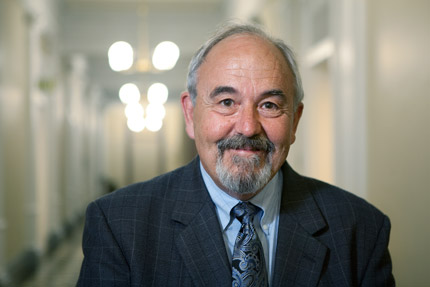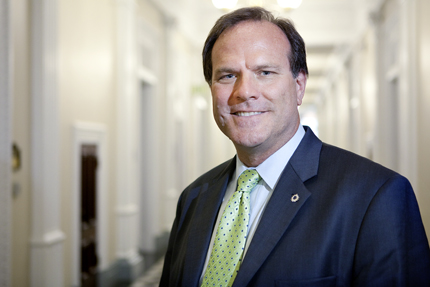Champions of Change Blog
Champions of Change: Going Green and Increasing Accessibility
Posted by on August 19, 2011 at 10:52 AM EDTAs an entrepreneur in the fields of alternative energy and transportation, Marc Klein is living proof of the importance of constant innovation. In 2006, Marc co-founded The Vehicle Production Group LLC (VPG), which is a new American automobile manufacturer that is making the first factory-direct wheelchair accessible vehicle that meets or exceeds the vehicle guidelines of the Americans with Disabilities Act (ADA) and is available in a compressed natural gas model (CNG). CNG is a “green” alternative fuel that is cleaner burning than gasoline, less expensive for drivers than gasoline, and is abundant here in the United States, so it reduces our nation’s dependency on foreign oil imports.
Marc has been at the forefront of the battle to improve transportation for people with disabilities by facilitating their independence. By combining the features of “universal design” and natural gas fuel, VPG’s car – called the MV-1 -- creates a win-win situation for everybody. In August 2008, VPG completed an equity financing of $160 million. Since the MV-1 is being assembled in Mishawaka, Indiana, it complies with the Buy America Act and is creating automotive jobs for Americans at this critical time.
Learn more about Disabilities, InnovationsChampions of Change: Reducing Drug Use and Building a Healthier America
Posted by on August 18, 2011 at 1:08 PM EDTEd. Note: Champions of Change is a weekly initiative to highlight Americans who are making an impact in their communities and helping our country rise to meet the many challenges of the 21st century.
Champions of Change isn’t just an initiative to highlight innovative achievements and stellar performers, it’s a chance to recognize that, across the country, the dedication and commitment of a single individual or organization can affect huge positive change. Recently, I had the pleasure of meeting with a handful of these dedicated individuals and celebrating the progress they are making to reduce the devastating effects of drug use and make American communities healthier and stronger.
Today’s news is often dominated by talk of the economy and jobs. And now, more than ever, it’s important to recognize that drug use harms every sector of this country. From keeping individual families together, creating a healthy and strong workforce, reducing the economic strain on the criminal justice system, and fostering a safe environment in local communities, tackling America’s substance abuse issues is vital for winning the future – and that’s exactly what this group of Champions of Change is doing.
Building Substance Abuse Prevention Programs
Posted by on August 18, 2011 at 10:38 AM EDTEd. Note: Champions of Change is a weekly initiative to highlight Americans who are making an impact in their communities and helping our country rise to meet the many challenges of the 21st century.
On August 5, 2011, I joined ten representatives from nine other agencies who were honored by the White House as Champions of Change for work to reduce drug use and its consequences, and for empowering and inspiring members of our communities. The individuals and programs represented the four-pronged approach the Administration is taking to address substance abuse in our nation: prevention, treatment, recovery and interdiction.
As a 30-year veteran in the substance abuse prevention field, I was thrilled to see drug abuse prevention listed as the first chapter in the 2011 National Drug Control Strategy, issued by the Office of National Drug Control Policy in July. The five Principles articulated in the Strategy encompass strategies that can be practiced by drug prevention coalitions and agencies across the Nation and which are based on modern research and best practices.
Learn more about , Health CareReducing Stigmas During Recovery from Drug Problems
Posted by on August 16, 2011 at 4:00 PM EDTEd. Note: Champions of Change is a weekly initiative to highlight Americans who are making an impact in their communities and helping our country rise to meet the many challenges of the 21st century.

Almost every family in America is touched by an often fatal malady – one that is sometimes denied, often ignored or covered up, and one that is completely treatable. People with alcohol or drug problems are found in every stratum of society and in every town and city. They are often misunderstood and often blamed for their disease, but when they pick up their mat and walk away it is many times with a new appreciation of life, a new more spiritually centered and service oriented attitude that makes them good neighbors, good employees and good friends. Recovery from alcohol and other drug problems happens every day. There may be up to 20 million Americans who have recovered from this seemingly hopeless condition of mind and body.
In El Paso, Texas people in the community of people in recovery have banded together to address issues such as stigma and discrimination for people in recovery and to provide peer-to-peer services. These services, which are delivered and developed by peers, include recovery coaching, a recovery community center and a peer run residential recovery center, called Casa Vida de Salud. Casa Vida has served over 1,500 homeless people with co-occurring mental health conditions as well as alcohol or other drug problems since 2005.
The Recovery Alliance has served over 15,000 people since the community banded together in 1998, and its community events are sometimes the proof that people need concerning having a rich and rewarding life after alcohol and drugs. The Alliance has over 1,000 members from the recovery community along with family members and community allies. Alliance workers provided over 20,000 units of service in 2010 and logged over 5,700 volunteer hours. The Alliance is supported by the US Department of Health and Human Services, the Texas Department of State Health Services, the City of El Paso, the Veteran’s Administration, the US Department of Housing and Urban Development and by the recovery community.
Uplifting Neighborhoods and Inspiring Young Change-makers
Posted by on August 16, 2011 at 1:09 PM EDTEd. Note: Champions of Change is a weekly initiative to highlight Americans who are making an impact in their communities and helping our country rise to meet the many challenges of the 21st century.
I was honored to be invited to the White House on August 5, as a White House Champion of Change. This followed inclusion of Safe & Sound in the Office of National Drug Control Policy 2011 Strategy.
ONDCP’s Director Gil Kerlikowske said about Safe & Sound: "This program is a unique, effective, and shining example of how community efforts can reduce drug use and its consequences. Safe & Sound is an example of a local community taking action and addressing this issue head on.”
Safe & Sound is a partnership of law enforcement, prosecutors, youth-serving organizations, elected and civic leaders, businesses, city services, and clergy aimed at reducing drug use and crime and rebuilding neighborhoods. The project organizes residents and youth and connects them with community resources to identify and report criminal activity and prevent youth gang affiliation, crime, and substance abuse. Safe and Sound utilizes 3 interdependent strategies of positive youth development at after-school “Safe Places”, neighborhood organizing through its Community Partners staff, and law enforcement. It is a unique, collaborative approach to fighting crime, violence, illegal drug and alcohol sales, drug houses, open air drug markets, prostitution, and blighted properties.
Safe & Sound empowers youth and adults to work together, creating a better, safer community for all. After-school Safe Places for youth operate during the hours when youth are most apt to commit, or become victims of, crime. Engaging more than 20,000 young people every year, the Safe Places involve them in youth-led crime reduction and neighborhood improvement projects, drug and alcohol prevention activities, and gang resistance and violence prevention efforts. Young people learn the importance of avoiding drugs, gangs, and guns. And, they learn the leadership skills to plan and execute projects to change their neighborhoods such as building parks, securing funds for street safety enhancements, and holding neighborhood crime analysis meetings. Programs offered include structured activities to help youth develop personal and social skills through interactive forms of learning.
The Sensible, Affordable Option of Solar Hot Water Heating
Posted by on August 12, 2011 at 1:58 PM EDTEd. Note: Champions of Change is a weekly initiative to highlight Americans who are making an impact in their communities and helping our country rise to meet the many challenges of the 21st century.

Since I was a young boy, I was always interested in how things worked, right down the tiniest detail. I would disassemble and reassemble everything from watches, to televisions, to motors. While doing so, I was always thinking about why something was constructed or done in one way, versus another. It was with this same analytical curiosity that compelled me to question why solar water heating, so popular in buildings around the world, lost its popular, widely adopted use, and instead became seldom-used and not worth pursuing as a product in business.
When I first started my career in the renewable energy industry, I was taken by the simplicity and cost effectiveness of solar water heating. A single solar panel on the roof of a home provides reliable hot water for a home at a cost that is very competitive with electric and gas. Even today the rest of the world uses solar energy to heat water. Realizing this, I have always held the idea that traditional utilities that deliver electricity, water, gas, or other services on a monthly basis could provide yet another service - solar water heating.
In the utility business a solar system installed in a home is called “distributed generation.” But wait doesn’t “generation” beget electricity? Unfortunately, that is where solar water heating is disadvantaged; it is neither electricity, nor conservation, nor generation supply. Hence, solar water heating tends to be ignored by utilities and businesses despite that fact that it is four to seven times more cost effective than PV (photovoltaic), and takes up equally as less roof space. In most States that have renewable goals (RPS) solar water heating is not an eligible technology, for no good reason at all. When you talk to regulators or policy people that claim it is an oversight. As a taxpayer and ratepayer I want my dollars spent wisely, and so should you!
Learn more about Energy and Environment
- &lsaquo previous
- …
- 161
- 162
- 163
- 164
- 165
- 166
- 167
- 168
- 169
- …
- next &rsaquo
White House Blogs
- The White House Blog
- Middle Class Task Force
- Council of Economic Advisers
- Council on Environmental Quality
- Council on Women and Girls
- Office of Intergovernmental Affairs
- Office of Management and Budget
- Office of Public Engagement
- Office of Science & Tech Policy
- Office of Urban Affairs
- Open Government
- Faith and Neighborhood Partnerships
- Social Innovation and Civic Participation
- US Trade Representative
- Office National Drug Control Policy
categories
- AIDS Policy
- Alaska
- Blueprint for an America Built to Last
- Budget
- Civil Rights
- Defense
- Disabilities
- Economy
- Education
- Energy and Environment
- Equal Pay
- Ethics
- Faith Based
- Fiscal Responsibility
- Foreign Policy
- Grab Bag
- Health Care
- Homeland Security
- Immigration
- Innovation Fellows
- Inside the White House
- Middle Class Security
- Open Government
- Poverty
- Rural
- Seniors and Social Security
- Service
- Social Innovation
- State of the Union
- Taxes
- Technology
- Urban Policy
- Veterans
- Violence Prevention
- White House Internships
- Women
- Working Families
- Additional Issues

